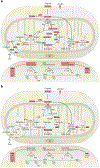Inflamed macrophages sans mitochondrial pyruvate carrier?
- PMID: 37188820
- PMCID: PMC10410471
- DOI: 10.1038/s42255-023-00789-9
Inflamed macrophages sans mitochondrial pyruvate carrier?
Abstract
Glycolysis provides building blocks for the proinflammatory activation of macrophages and simultaneously generates pyruvate. In this issue of Nature Metabolism, Ran et al. provide evidence that the transport of pyruvate to fuel the Krebs cycle in the mitochondria is not required in the inflammatory response.
Conflict of interest statement
Competing interests
L.Y.-C. and E.B.T. declare no competing interests.
Figures

Comment on
-
Mitochondrial pyruvate carrier-mediated metabolism is dispensable for the classical activation of macrophages.Nat Metab. 2023 May;5(5):804-820. doi: 10.1038/s42255-023-00800-3. Epub 2023 May 15. Nat Metab. 2023. PMID: 37188821
References
Publication types
MeSH terms
Substances
Grants and funding
LinkOut - more resources
Full Text Sources
Miscellaneous

